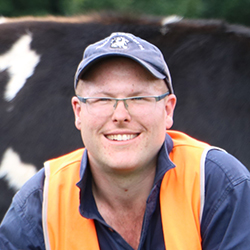By Rohan Borojević, Industry Development Officer at the Tasmanian Institute of Agriculture
A three-year project is underway at TIA's Dairy Research Facility to better understand the impact that different pasture species and fertiliser applications have on soil health.
Soils under permanent pasture are often thought to be in reasonably good condition. This is mainly due to less frequent cultivation which allows ground cover and soil structure to be maintained or even improved.
But can different pasture species and amounts of applied fertiliser further improve these soils?
This is the question that will be answered through a current three year project funded by Dairy Australia and led by Research Fellow Dr Adam Langworthy.
Four farmlets or miniature farms have been set up at TIA's Dairy Research Facility at Elliott (TDRF). The first two farmlets contain a mix of 80 percent perennial ryegrass and 20 percent white clover, with farmlet one receiving 300 kg of nitrogen per year and farmlet two receiving 150 kg of nitrogen per year.
Farmlet three has 40 percent perennial ryegrass, 30 percent white clover and 30 percent plantain with 150 kg of nitrogen applied per year.
Farmlet four is a diverse pasture mix with 40 percent mixed grasses, 30 percent mixed clovers and 30 percent mixed herbs with little to no nitrogen applied.
These farmlets will be used to understand the effects of different pasture species and fertiliser applications on above ground measurements such as milk and pasture production, as well as financial performance and viability. Researchers are also very interested in looking below ground to see what, if any, changes occur in the soil as a result of the different farmlet treatments.
Several carbon and nitrogen measurements will be taken from 600 mm deep cores. These tests will also be done at 100 mm depth, with additional biological measurements. These will include DNA sequencing of the soil microbial community, earthworm counts, as well as other tests to try and explain the potential differences in these biological measurements.
It's hoped that the findings from this project will support farmers make decisions on what pastures will be best for their animals, business, and the soils that drive these businesses. The project will also provide baseline soil data which will allow changes to be tracked into the future.
To hear updates from the project, sign up for the Tasmanian Institute of Agriculture’s digital newsletter.



